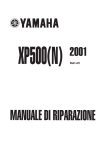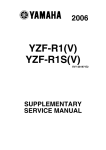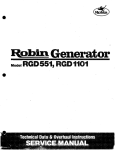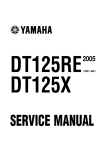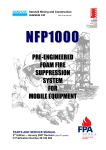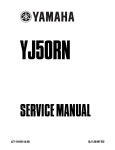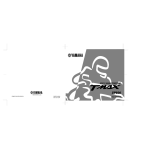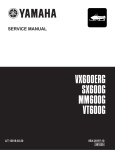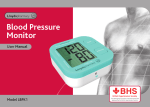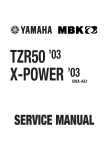Download Yamaha Tmax XP500Z Specifications
Transcript
XP500 TMax Technical Orientation Guide FEATURES AND BENEFITS Offering high levels of performance, comfort and sophistication, the new TMax superscooter looks sure to make as great an impression on the powered two wheeler market as the first Yamaha YZFR1 made in the motorcycle scene. ENGINE FEATURES CHASSIS FEATURES n 499cc liquid cooled 4-stroke parallel twin engine n DOHC 8 valve engine n High capacity V-belt transmission n Horizontally opposed reciprocating balancer n Wet multiple plate automatic centrifugal clutch n New design air intake route and air filter case n Low position radiator n Semi dry sump with oil cooler n Non adjustable 2-stage silent chain drive train n Motorcycle-type high rigidity diamond shape frame n Motorcycle-type front fork n Highly rigid swingarm n 14 inch front and rear wheels n Motorcycle-type hub with fixed rear wheel axle n Sport bike type weight distribution n 50º lean angle n 33 liters luggage compartment n 1 piece dual seat with 3-stage adjustable backrest ELECTRICAL FEATURES n Dual multi-reflector headlight n Stylish combination taillight n Automobile-type meter panel with extensive information n High capacity power supply n Anti-theft alarm pre-wiring n Grip warmer pre-wiring n Mobile phone charger pre-wiring 1 XP500 TMax Technical Orientation Guide ENGINE SYSTEM Displacing 499 cc, the TMax’s highly-advanced fully automatic twin-cylinder DOHC liquid-cooled 4-stroke 8-valve engine is one of the most powerful designs available on scooters today. A key feature of its configuration is that unlike most traditional scooter engines which pivot as one unit with the rear suspension, this engine is fixed rigidly into the TMax’s strong tubular diamond-shape frame in order to achieve higher levels of chassis rigidity for enhanced handling performance. The swingarm is mounted to a pivot point at the rear of the engine, thereby keeping unsprung weight low for more responsive rear suspension action. Another innovative feature is the horizontal configuration of the engine that keeps the centre of gravity low for easy handling and also gives extra storage space under the dual seat. ENGINE FEATURES n Parallel twin with 360 degree crankshaft n 66 mm bore and 73 mm stroke n 10.1 :1 compression ratio n Left side drive cam chain for reduced engine width Horizontal compact cylinder head Horizontally opposed reciprocating balancer Semi dry sump High capacity V-belt transmission Wet multiple plate automatic centrifugal clutch Non adjustable 2-stage silent chain drive train Pivot coaxial drive shaft eliminates chain backlash 4 2 3 1 5 2 7 6 XP500 TMax Technical Orientation Guide CYLINDER HEAD n n n n 4 valves per cylinder, DOHC Torsion type auto cam chain tensioner (similar to YZF-R1) “Shim-under-bucket” valve adjustment for long maintenance interval (same as YZF-R1/YZF-R6) Valve clearance at cold engine condition: Intake : 0.15 - 0.20 mm Exhaust: 0.25 - 0.30 mm 1 2 Intake camshaft Cam chain tensioner Exhaust camshaft Silent cam chain 4 3 Intake port Exhaust port Air Induction Ports TDC 105º (1) 25.0 22.0 (2) 4.0 4.0 (3) 83.3 82.8 25º 105º OL 50º Intake valve Exhaust valve (mm) (mm) (2) (3) 25º IN EX 55º 55º BDC (1) VALVE TIMING 3 XP500 TMax Technical Orientation Guide CYLINDER n New liquid-cooled cylinder body for low weight n Left side cam chain drive for reduced engine width n Ceramic composite cylinder coating for increased cooling and longer wear life Side view Side cam chain drive ø 66.0 mm ø 66.0 mm Top view 4 XP500 TMax Technical Orientation Guide CRANKSHAFT / BALANCER n New design crankshaft uses replaceable full circumference plain bearings n Horizontally opposed reciprocating balancer for excellent vibration reduction This type achieves same vibration reduction as 3 balancer shafts to reduce primary and secondary inertial forces, while requiring less space. Piston cylinder #1 Piston cylinder #2 Cam chain drive gear Balancer piston 1 2 bearing size indication 3 4 Bearing size indication, reading from left to right (ex. 1 2 3 4 5): Left main bearing Right main bearing Conrod bearing cylinder #1 Conrod bearing balancer cylinder Conrod bearing cylinder #2 Balancer cylinder 5 XP500 TMax Technical Orientation Guide PISTON n New combustion piston with V-groove between upper and lower compression rings for improved sealing n Balancer piston for horizontally opposed reciprocating balancing system COMBUSTION PISTON Top view V-groove Cross-section Side view ø 40 mm ø 66 BALANCER PISTON Top view Front view Side view 71.7 mm ø 58 Front view cross-section 6 XP500 TMax Technical Orientation Guide CONNECTING ROD n Newly designed connecting rods: 2 for combustion, 1 for balancer n New type connecting rod as integral part of the horizontally opposed reciprocating balancing system FOR BALANCER FOR COMBUSTION 16 mm 117 mm 124.5 mm 15 mm 45 mm 45 mm All connecting rods use the same 2-piece plain bearings 7 XP500 TMax Technical Orientation Guide TRANSMISSION SYSTEM CONTINUOUSLY VARIABLE TRANSMISSION n Highly efficient V-belt transmission in order to obtain high performance n Newly designed cooling system with fins on both rotors of the secondary sheave for improved cooling and higher belt durability n Cooling system uses 2 air filters to provide high volume clean air cooling 2 1 3 4 Engine left side Engine right side 5 Left transmission air filter Air intake duct to transmission Right transmission air filter Air exhaust ports Cooling fin Secondary sheave 6 V-belt exchange: each 20,000 km Engine cross-section rpm Speed shift rate diagram speed 8 XP500 TMax Technical Orientation Guide CLUTCH n Wet type multiple plate centrifugal clutch for smooth power transmission and to meet XP’s higher torque n Clutch uses diaphragm type spring Friction plates: 5 pieces Clutch plates: 6 pieces Diaphragm clutch spring Primary drive gear Main axle 1 3 4 First pinion gear Secondary shaft First wheel gear Drive axle Primary driven gear 5 6 7 8 5 10 9 2 Transmission gear reduction ratio = (primary driven gear / primary drive gear) x (first wheel gear / first pinion gear) = (52 / 32) x (36 / 22) = 2.659 Clutch-in revolution: 1800 ± 300 rpm 9 XP500 TMax Technical Orientation Guide FINAL DRIVE n Newly designed final drive with non-adjustable 2-stage silent chain for an efficient power transmission, reduced noise and low maintenance n High speed first stage chain with spring-type torque absorber for a further reduction of noise n The final drive and the swingarm are integrated for improved rigidity and high speed stability Crankcase Drive axle First stage drive chain Second stage drive chain Taper roller bearing 1 2 3 Mounted on rear wheel clutch hub 5 Gear ratio: (41 / 25) x (40 / 29) = 2.262 Rear drive case Oil dip stick 4 1 Final drive oil capacity: 700 cc Type: SAE 80, hypoid 2 Oil level 10 XP500 TMax Technical Orientation Guide LUBRICATION SYSTEM n n n n n Semi dry sump system for reduced engine size Oil tank is incorporated into the left crankcase cover Newly designed dual stage oil pump Liquid-cooled oil cooler with cartridge type oil filter (5DM-13440-00) New type oil drain bolt that allows oil from crankcase and oil tank to be drained at the same time Dual stage oil pump brings oil from oil tank to respective areas of the engine, including a spray bar over the starter gears and the stator assembly. The oil pump also has a scavenging pump that returns the oil to the oil tank. The scavenged oil fills the tank until it is full and then overflows back into the sump area to maintain a constant level in the sump. Oil filter Oil cooler Oil spray bar Crankcase cover Oil tank space Oil pump Drain bolt 3 4 5 1 2 7 6 Engine oil capacity Total amount : 3.6 liters = 2.2 liters in crankcase + 1.4 liter in oil tank Without oil filter replacement : 2.8 liters With oil filter replacement : 2.9 liters Engine oil change: every 5,000 km 11 XP500 TMax Technical Orientation Guide LUBRICATION SYSTEM LUBRICATION FLOW CHART 12 XP500 TMax Technical Orientation Guide LUBRICATION SYSTEM 13 XP500 TMax Technical Orientation Guide COOLING SYSTEM n Low mounted radiator for design flexibility n Automatic air bleed for easy maintenance Coolant Reservoir Tank Thermostat Radiator Water pump Coolant Fan Radiator Cap Cooling system capacity: 1.5 liter Carburetor heating thermostat: Coolant temperature is less than 80±2 ºC: OPEN Coolant temperature is more than 80±2 ºC: CLOSED Main thermostat: Coolant temperature is less than 82±2 ºC: OPEN Coolant temperature is more than 82±2 ºC: CLOSED 14 XP500 TMax Technical Orientation Guide CARBURETION SYSTEM n n n n n Twin BS30 round slide carburetors Automatic choke for easy starting Throttle Position Sensor to optimize ignition timing and reduce emissions Coolant type carburetor heater Pull-pull type throttle control Auto Choke Unit Throttle Position Sensor 2 1 Carburetor settings Marking 5GJ1 Main jet #105 Jet needle 4DK4-3 Needle jet 0 - 0M Pilot jet #22.5 Pilot screw turns out 2 1/2 Auto-choke electricity control. By thermo switch. coolant temperature is more than 60 ± 3ºC: ON coolant temperature is less than 55 ± 3ºC: OFF By TCI Unit more than 800 rpm: ON less than 375 rpm: OFF 15 XP500 TMax Technical Orientation Guide AIR INTAKE SYSTEM n Air filter case position in upper front body cowling for effective use of space n Air intake system uses noise reduction box n Air Induction System for reduced emissions Air filter case Noise reduction box Vacuum hose to Air Cut Valve Fuel pump Reed valve Air hose (Reed Valve - Air Cut Valve) Air Cut Valve 1 See Service Tips for CO adjustment and Air Induction System check procedure 2 7 3 4 6 To exhaust port 5 BLOCK HERE FOR CO ADJUSTMENT 16 XP500 TMax Technical Orientation Guide EXHAUST SYSTEM n 2 into 1 stainless exhaust pipes and stainless muffler Muffler Exhaust Pipe EGA connection 1 2 17 3 XP500 TMax Technical Orientation Guide CHASSIS Like the all-new engine, the TMax’s advanced high-rigidity chassis has been developed using some of the latest motorcycle technology in its frame and suspension designs. n Sports bike type front and rear weight distribution of 47% and 53% respectively n Ground clearance: 140 mm n 50º lean angle FRAME n Newly designed tubular diamond shape frame n Frame uses engine as a stressed member for added rigidity and enhanced handling performance n Total configuration keeps centre of gravity low and wheelbase short References XP500 YP250 Overall length 2,235 mm 2,120 mm Wheelbase Min. turn radius Engine mounting positions 18 1,575 mm 1,540 mm 2.8 m 2.6 m XP500 TMax Technical Orientation Guide FUEL TANK n n n n Steel fuel tank just under rider seat Fuel lid in rider seat with easy access to fuel cap Fuel tank capacity is 14 liters Electric fuel pump for stabilized fuel supply uses external fuel filter Fuel lid Fuel tank cap Fuel tank 1 2 3 BODYWORK n Completely new aerodynamically-efficient sports styled bodywork Integrated turn signal lights Aluminium grab bar for improved passenger comfort 1 2 19 XP500 TMax Technical Orientation Guide WINDSCREEN n Large size windscreen for enhanced weather protection n Newly designed cowling mounted mirrors SEAT n One piece deeply padded dual seat n Rider seat features adjustable backrest offering 35 mm of movement in three stages n Seat is locked at left and right side for enhanced security Fuel lid Adjustable backrest 2 1 35 mm Seat height: 795 mm 20 XP500 TMax Technical Orientation Guide STORAGE COMPARTMENTS n Small compartment in the right side front cowling of 1.2 liter for sunglasses, mobile phone, etc. n Rear storage compartment under seat of 33 liters and it can hold a full face helmet or B4 size bag n Rear storage compartment has an interior light, a special area for a U-lock and pre-wired for a 12V accessory plug Battery Seat locks Fuse box Front storage compartment Rear storage compartment Interior light 2 1 336 mm 3 6 5 340 mm 5 440 mm 21 4 XP500 TMax Technical Orientation Guide FRONT SUSPENSION n Motorcycle type front suspension uses upper clamp and 38 mm fork tubes for increased high speed stability n Front wheel travel: 120 mm Lower clamp Upper clamp Ball bearings 2 Top view 1 3 Oil level: 135 mm Oil type: SAE 7.5 WT REAR SUSPENSION / SWINGARM n Single pull type rear shock absorber horizontally positioned underneath the engine for low centre of gravity and increased storage space n Swingarm and final drive are combined for improved rigidity n Swingarm pivots independently of engine for more responsive suspension reaction n Rear wheel travel and shock absorber stroke: 120 mm Swingarm Shock absorber Top view of swingarm Final drive 1 2 22 XP500 TMax Technical Orientation Guide FRONT WHEEL / TIRE / BRAKE n New 14 x MT 3.50 cast wheel n Front disc brake diameter: 282 mm n Front brake: two piston pin slide-type caliper Front brake caliper Front wheel Tires. Dunlop Bridgestone : D305FA 120/70-14 M/C 55S : HOOP B03 120/70-14 M/C 55S REAR WHEEL / TIRE / BRAKE n n n n New 14 x MT 4.50 cast wheel Rear wheel uses motorcycle-type clutch hub and fixed axle for enhanced stability Rear disc brake diameter: 267 mm Rear brake: 1 piston pin slide-type caliper Rear brake caliper Clutch hub 1 2 Tires. Dunlop Bridgestone : D305 150/70-14 M/C 66S : HOOP B02 150/70-14 M/C 66S 23 1 XP500 TMax Technical Orientation Guide ELECTRICAL SYSTEM GENERATOR n The generator supplies ample power for electrical accessories n Generator capacity: 22A, 14V @ 5000 rpm n The optional electrical accessories are: mobile phone charger, grip warmers and anti-theft alarm system HEADLIGHT ASSEMBLY n Newly designed multi-reflector dual headlight Low beam High beam Auxiliary lights : 12V, 55W (H7 - 12V, 55W) : 12V, 60W (H4 - 12V, 60/55W) : 12V, 5Wx2 For UK specifications, the positions of the left and right headlights are opposite 1 2 3 24 XP500 TMax Technical Orientation Guide TAILLIGHT ASSEMBLY n Newly designed dual taillight Tail / brake light : 12V, 21/5W Turn signal light : 12V, 21W License plate light : 12V, 5W License plate light Taillight 2 2 3 1 LEAN ANGLE CUT-OFF SWITCH Shuts off fuel pump if TMax falls on its side with running engine Switch can not be activated if TMax is leaned over while cornering If activated, the main switch must be turned “off” and then back “on” again to start the engine ANTI-THEFT ALARM PRE-WIRING n Main wiring harness is pre-wired from factory with connectors for an aftermarket alarm system n Location: behind left side body cover GRIP WARMER PRE-WIRING n Main wiring harness is pre-wired from factory with connectors for an aftermarket grip warmer n Location: under handlebar cover MOBILE PHONE CHARGER PRE-WIRING n Main wiring harness is pre-wired from factory with connectors for an aftermarket mobile phone charger n Location: behind right side body cover 25 XP500 TMax Technical Orientation Guide INSTRUMENTATION n Automobile-style instrument panel for extensive information and easy reading n Speedometer uses electronic front wheel speed sensor (same type as FZS600) n Main switch has luminescent ring (similar to YP250) Digital clock Speedometer with integrated trip/odometer Coolant temperature gauge Fuel gauge Oil indicator reset button 1 10 9 8 Trip meter reset button High beam indicator V-belt change indicator Engine oil change indicator Time set buttons (left minutes / right hours) 2 7 3 6 4 5 l Oil change indicator lights up at 1,000 km, 5,000 km and then every 5,000 km. l V-belt indicator lights up every 20,000 km. See Service Tips for details. 26 XP500 TMax Technical Orientation Guide SERVICE TIPS The Service Tips portion of the Technical Orientation Guide is designed to further familiarize you with some key servicing points of the TMax. It is not designed to replace the TMax Service Manual. For complete servicing details please refer to the Service Manual. ENGINE OIL LEVEL CHECK Start checking from cold engine condition. n Put the TMax on the main stand on level ground and check that the oil is at minimum level in the sight glass. If not, add enough oil to bring it up to the minimum level and start the engine for about 2 to 3 minutes so the oil sufficiently circulates through the system. n Turn the engine off and let it sit for a couple of minutes to allow the oil to settle into the sump and recheck the level. Add oil to the tank if necessary until the oil is at the proper level in the sight glass. FINAL DRIVE OIL LEVEL CHECK With the TMax still on the main stand: n Remove the two screws and the plastic cover on the left side of the swingarm n Remove the dipstick and wipe clean n Reinsert the dipstick but do not screw it in n Remove again and check the level. If it is below the full level add oil accordingly. RADIATOR FILL The radiator fill cap is located just inside the lower right side of the front fairing near the front tire. COOLANT RESERVOIR There is a small cutout on the right side cowl under the floorboard area to check the reservoir coolant level. If coolant is below the minimum level, pull up the rubber floorboard mat and remove the screw that holds the filler cap access lid and the cap to add coolant. AIR FILTER REPLACEMENT n Remove the mirrors and the windshield with the base, do not remove the windshield from the base, to access the air box. n Remove the airbox cover and air filter. PROPER REMOVAL OF THE MIDDLE SIDE PANELS Some caution should be taken when removing these panels to prevent damaging them. n Remove the two allen screws from the front and the allen screw near the passenger footrest n Now pull on the bottom of the panel to pop the tabs out of the rubber grommets n Then push the panel upward from the bottom to pop out the top section. FUEL PUMP AND FILTER The fuel pump and filter are located underneath the right middle side panel. 27 XP500 TMax Technical Orientation Guide CARBURETOR ACCESS Carburetor adjustment is easily accessible through the center of the floorboard. The vacuum plugs for carburetor synchronization are on the intake manifolds and the fuel mixture screws for CO adjustment are on the top of carburetors. AIR CUT VALVE The Air Cut Valve for the Air Induction System is located under the windshield on the left side of the air box. AIR INDUCTION SYSTEM REED VALVE When performing the CO adjustment, be sure to block off the large hose to the reed valve located under the left floorboard. This will prevent air from entering the system and giving inaccurate readings. CO ADJUSTMENT / AIR INDUCTION SYSTEM CHECK PROCEDURE CO ADJUSTMENT 1 2 3 4 5 Cut the secondary air supply by blocking the hose between the Air Cut Valve and the Reed Valve (See pg.16 for Illustration). Connect the exhaust gas analyzer to the head pipe fittings. Disconnect the crankcase breather hose. This will prevent any oil contamination or combustion blow-by from affecting the EGA readings. Warm up the engine for several minutes at idle rpm. Adjust the CO while maintaining the following conditions:: n Oil temperature : 65 ~ 75 ºC n Coolant temperature : 75 ~ 85 ºC n Intake vacuum : 33 ~ 39 kPa n Idle revolution : 1150 ~ 1250 rpm. CO measurement should be: 3.0% AIR INDUCTION SYSTEM CHECK PROCEDURE 1 2 3 Adjust CO following the above procedure. Restore the secondary air supply to the air induction system unit. Check the CO reading while maintaining the above conditions (oil temperature, coolant tempera ture , intake vacuum and idle rpm). 4 CO reading should be: 0.5% NOTE: Reconnect the crankcase breather hose and check the CO reading again. If the CO level is much higher, the engine oil may be contaminated with gasoline or the engine may be suffering from poor mechanical condition. Change the engine oil and check the CO level again. If the reading is still out of specification, check the engine for a mechanical problem. V-BELT TRANSMISSION AIR FILTERS One of the V-belt transmission air filters is located under the left side panel next to the fuel tank and the other one is inside the right crankcase cover in front of the secondary sheave. HEADLIGHT BULB ACCESS The head light bulbs can be accessed by reaching up under the front cowling. TAILLIGHT AND REAR TURN SIGNAL BULB ACCESS The taillight and turn signal bulbs can be accessed after removing the aluminium grab rail, middle and side sections of the tail cowl. 28 XP500 TMax Technical Orientation Guide OTHER COMPONENTS LOCATED UNDER REAR COWL n The Main fuse, starter relay, flasher relay, starter cut-off relay, fuel pump relay, seat lock cable junction and regulator/rectifier are all located under the right side rear cowl. n The stator, pick up coil and alarm connectors are located under the left side. THERMO SENSOR AND THERMO SWITCH The thermo switch for the auto choke is located directly on the thermostat housing and the thermo sensor for the temperature gauge is next to the thermostat on the cylinder. The electric cooling fan is mounted directly on the radiator and is controlled by a thermo switch mounted on the left upper corner of the radiator. REAR WHEEL REMOVAL To remove the rear wheel, place the TMax on the main stand on level ground. n Take off the plastic cover on the left side of the swingarm. n Remove the axle nut. n Remove the rear brake caliper from the swingarm. n Loosen the axle pinch bolt on the right side. n Remove the axle and spacer. n Pull the wheel to the right to slide the hub out of the splines and pull the wheel out of the swingarm. n Be sure to grease the hub splines before re-installation. V-BELT REPLACEMENT The V-belt on the TMax can be replaced by taking off: l Right middle side panel l Right floorboard l Small shroud l Rear passenger footpeg l Muffler stay bolt l Plastic cover from V-belt transmission cover. n Move the fuel filter and pump out of the way. n Remove the V-belt transmission cover while moving the muffler out of the way. n Install two 45 x 6 mm bolts into the threaded holes of the secondary sheave. n Tighten the bolts evenly until the secondary sheave is spread apart far enough so that the V-belt can be removed. n Install the new belt and remove the bolts. To reset the V-belt indicator light, disconnect the 2-pin jumper connector for 2 to 5 seconds with the main switch turned on, then reconnect it. 29 XP500 TMax Technical Orientation Guide CHECKING TDC AND CAM TIMING POSITION n n n n Remove the left and right floorboards as shown earlier. Remove the valve cover according to the service manual. Remove the inspection plug on the left crankcase cover just above the water pump. Remove the small cover on the front of the right side crankcase cover to access the primary sheave nut. n Rotate the primary sheave nut clockwise until the TDC mark on the rotor is aligned with the mark in the inspection window. The number one cylinder will also be at TDC of its compression stroke when the small holes on both camshaft sprockets are even with the cylinder head surface and facing towards the intake side of the engine. VALVE ADJUSTMENT PRECAUTION Because of the near horizontal angle of the cylinder head, the exhaust valve lifters may have a tendency to slide out of their pockets when the cams are removed. If this occurs the adjustment shim may fall out of the valve retainer and damage the cylinder head if the engine is run in this condition. To prevent this from happening, apply a small amount of grease to the adjusting shim and the valve lifter before reassembly. This will hold the shim and lifter in place while the cams are reinstalled and timed. RESET ENGINE OIL CHANGE INDICATOR To reset the engine oil indicator, push the oil indicator reset button on the instrument panel for 2 - 5 seconds. The required reset time is to prevent accidentally resetting the oil change indicator (i.e. the counter in the igniter-unit). See also Self-diagnostics. SELF-DIAGNOSTICS The oil indicator light of the TMax has 3 functions: n Oil indicator bulb check n Indicate replacement timing of engine oil n Indicate an electrical problem (self-diagnostics). Function 1 The oil indicator lights up momentarily when the main switch is turned on, in order to indicate that the oil indicator light bulb is working properly. Function 2 The oil indicator lights up continuously in order to indicate that the engine oil has to be replaced. It lights up initially at 1,000 km and 5,000 km, after that it lights up every 5,000 km (10,000 15,000 - etc.). NOTE: The mileage is counted by the igniter after every reset, it therefore is possible that the timing of the light is different from the odometer reading. 30 XP500 TMax Technical Orientation Guide Function 3 If the igniter detects an electrical problem, the engine oil indicator will flash according to patterns mentioned as Condition Codes in the table below. Circuit TPS l l l Defect(s) System Response Disconnected l The igniter-unit stays set to wide-open Short circuit. throttle ignition timing. Mechanical l Oil indicator displays condition code. Malfunction. Condition Code Speed l Disconnected l Oil indicator displays condition code. Sensor Remarks Light on : 0.5 s Light off : 0.5 s Pattern interval: 3.0 s Lean l Disconnected l The system stops fuel pump operation. Angle l Short circuit. l Oil indicator displays condition code. Switch l Mechanical Malfunction. SPECIAL TOOLS There are three new special tools introduced for the TMax: Primary Clutch Holder Part Name Part Number Primary Clutch Holder 90890-01482 Sheave Holder 90890-01481 Plain Bearing Installer/Remover 90890-04139 31 XP500 TMax Technical Orientation Guide PRIMARY SHEAVE REMOVAL AND DISASSEMBLY After the V-belt has been removed: n Install the sheave holder on the primary sheave. n Take off the nut. n Take off the front sheave. n Take off the rear sheave from the crankshaft. To disassemble the primary sheave: n Remove the screws. n Remove the sheave cap. n Remove the cam. n Remove and inspect the weights and sliders for damage. Sheave holder used on primary sheave Clean and check the sheave surfaces for cracks or other damage. Clean the entire sheave assembly of the old grease and repack it with 80 to 90 grams of the same special sheave grease as used on the YP250 and re-assemble. When re-installing the primary sheave on the crankshaft, be sure to grease the crankshaft splines with the special grease and that the sheave plate splines are properly aligned with the crankshaft splines. SECONDARY SHEAVE REMOVAL AND DISASSEMBLY Follow the same procedures for the secondary sheave removal as the primary sheave using the opposite side of the sheave holding tool: n Install the secondary spring compressor tool in a vise. n Install the secondary sheave onto the tool. n Remove the nut and spring from the assembly. n Then separate the sheaves by removing the collar and pins from the cam. Sheave holder used on secondary sheave Clean and inspect all parts for wear or damage. Lube all sliding parts with assembly lube and reassemble the sheave. MAIN BEARING REPLACEMENT Because the TMax uses full circumference plain bearings, it is necessary to use the special bearing installer/remover to remove and install them. Use extreme caution when installing these bearings to prevent damage. For detailed drawings and instructions refer to the XP500 Service Manual. 32 Following special tools are NOT new, but they are used only for ATV. It is possible that motorcycle dealers have do not have the proper tools. XP500 TMax Technical Orientation Guide PERIODIC CHECKS AND ADJUSTMENTS This chapter includes information necessary to perform recommended checks and adjustments. If followed, these preventive maintenance procedures will ensure more reliable vehicle operation, a longer service life and reduce the need for costly overhaul work. This information applies to vehicles already in service as well as to new vehicles that are being prepared for sale. All service technicians should be familiar with this entire chapter. 33 XP500 TMax Technical Orientation Guide GENERAL SPECIFICATIONS XP500 – General Specifications Dimensions: Overall length Overall width Overall height Seat height Wheelbase Minimum ground clearance Weight: Dry (without oil and fuel) Wet (with oil and a full fuel tank) Maximum load-except motorcycle Performance: Minimum turning radius Engine: Engine type Cylinder arrangement Displacement Bore x stroke Compression ratio Standard compression pressure (at sea level) Starting system type Lubrication System: Type Oil Type or Grade: Engine oil Chain drive oil Oil Capacity: Periodic oil change With oil filter replacement Total amount Chain Drive Oil: Total Amount Radiator Capacity (including all routes) Air Filter: Type Fuel: Recommended fuel Fuel tank capacity Carburetor: Type/quantity Manufacturer Spark Plug: Type Manufacturer Spark plug gap 2235mm 775mm 1410mm 795mm 1575mm 130mm 197kg 217kg 183kg 2800mm Liquid cooled 4-stroke, DOHC Forward inclined parallel 2-cylinder 499cc 66 x 73mm 10.1:1 1450kPa/360r/min (14.5kgf/cm2/360r/min) Electric starter Dry sump SAE 10W30SE or SAE10W40SE SAE80API ”GL-4” hypoid gear oil 2.8L 2.9L 3.6L 0.7L 2.4L Dry element Regular unleaded gasoline 14L BS30/2 Mikuni CR7E NGK 0.7~0.8mm 34 XP500 TMax Technical Orientation Guide GENERAL SPECIFICATIONS Transmission: Primary reduction system Primary reduction ratio Secondary reduction system Secondary reduction ratio Clutch type Transmission type Chassis: Frame type Caster angle Trail Tire: Tire type Size(front) Size(rear) Manufacturer (front) Manufacturer (rear) Brake: Front brake type Rear brake type Suspension: Front suspension Rear suspension Shock Absorber: Front fork type Rear shock absorber assembly type Wheel Travel: Front wheel travel Rear wheel travel Electrical: Ignition system type Charging system type Battery voltage/capacity Battery type Headlight type Headlight bulb type Bulbs (voltage/wattage x quantity) Headlight Headlight Auxiliary light Brake /tail light Front flasher light Rear flasher light Licence plate light Meter light Indicator light Turn indicator light Helical gear/spur gear 52/32x36/22(2.659) Chain drive 41/25x40/29(2.262) Wet multiple-disc automation V-Belt automatic Diamond 28º 95mm Tubeless 120/70-14M/C 55S 150/70-14M/C 66S Dunlop/Bridgestone Dunlop/Bridgestone Single disc brake Single disc brake Telescopic fork Swingarm Coil spring/oil damper Coil spring/gas-oil damper 120mm 120mm Transistorized coil ignition (digital) A.C. magneto 12V8Ah GT9B-4 Bulb type halogen bulb 12V60W/55Wx1 12V55Wx1 12V5Wx1 12V21W/5Wx2 12V21W/5Wx2 12V21Wx2 12V5Wx1 12V1.7Wx1 12V3.4Wx2 35 XP500 TMax Technical Orientation Guide GENERAL SPECIFICATIONS Oil level indicator light High beam indicator light V-belt replacement indicator light Tire pressure (cold): Loading condition A Front Rear Loading Condition B Front Rear High speed riding Front Rear Maintenance Specification Cylinder Head Volume Max. warpage Cylinder Bore Taper limit Max. out of round Chamshaft Drive system Camshaft cap inside diameter Camshaft-journal-to-camshaft-cap clearance Camshaft lobe dimensions Intake-measurement A Intake-measurement B Intake-measurement C Exhuast-measurement A Exhaust-measurement B Exhaust-measurement C Valve Timing: Intake-open (BTDC)((degree)) Intake-closed (ABDC) ((degree)) Exhaust-open (BBDC) ((degree)) Exhaust-closed (ATDC) ((degree)) Overlap angle “A” ((degree)) Max. camshaft runout Timing Chain: Model/Number of links Tensioning system Valve, valve seat, valve guide: Valve clearance-intake (cold) Valve clearance-exhuast (cold) Valve Dimensions: Valve head diameter A intake 12V1.7Wx1 12V1.7Wx1 12V1.7Wx1 0~90kg 200kPA(2kgf/cm2) 225kPa(2.25kgf/cm2) 90~183kg 225kPa(2.25kgf/cm2) 250kPa(2.5gf/cm2) 225kPa(2.25kgf/cm2) 250kPa(2.5kgf/cm2) 14.97~15.57cc 0.03mm 66.00~66.01mm 0.05mm 0.05mm Chain drive(left) 23.000~23.021mm 0.020~0.054mm 33.252~33.352 24.956~25.056 8.196~8.396mm 33.252~33.352 24.956~25.056 8.196~8.396 25º 55º 55º 25º 50º 0.03mm SCR-0409 SDH/132 Automatic 0.15~0.20mm 0.25~0.30mm 24.9~25.1mm 36 XP500 TMax Technical Orientation Guide GENERAL SPECIFICATIONS Valve head diameter A exhaust Valve face width B intake Valve face width B exhaust Valve seat width C intake Valve seat width C exhaust Valve margin thickness D intake Valve margin thickness D exhaust Valve stem diameter-intake Valve stem diameter-exhaust Valve guide inside diameter-intake Valve guide inside diameter-exhaust Valve stem to valve guideclearance-intake Valve stem to valve guideclearance-exhaust Valve stem runout Valve seat width-intake Valve seat width-exhaust Valve seat material-intake Valve seat material-exhaust Valve spring: Free length-intake Free length-exhaust Spring rate-intake (K1) Spring rate-intake (K2) Spring rate-exhaust (K1) Spring rate-exhaust (K2) Installed length-intake (valve closed) Installed length-exhaust (valve closed) Spring tilt-intake ((degree)) Spring tilt-exhaust ((degree)) Winding direction-intake(top view) Winding direction-exhaust(top view) Piston: Piston part number (***-11631-**) Piston-to-cylinder clearance <Limit> Diameter D Height H Offset Offset direction Piston pin bore inside diameter Piston pin outside diameter Piston ring: Top ring: Ring type Dimensions (B x T) End gap (installed) Ring side clearance 21.9~22.1mm 1.14~1.98mm 1.14~1.98mm 0.9~1.1mm 0.9~1.1mm 0.6~0.8mm 0.6~0.8mm 3.975~3.990mm 3.960~3.975mm 4.000~4.012mm 4.000~4.012mm 0.010~0.037mm 0.025~0.052mm 0.04mm 0.9~1.1mm 0.9~1.1mm PB6 V557W 35.59mm 35.59mm 18.845N/mm(1.92kgf/mm) 24.52N/mm(2.5kgf/mm) 18.845N/mm(1.92kgf/mm) 24.52N/mm(2.5kgf/mm) 30.39mm 30.39mm 2.5º/1.6mm 2.5º/1.8mm Clockwise Clockwise 5GJ-11631-00 0.020~0.045mm 0.15mm 65.965~65.980mm 9mm 0.5mm Intake side 16.002~16.013mm 15.991~16.000mm Barrel 0.80x2.45mm 0.15~0.25mm 0.030~0.065mm 37 XP500 TMax Technical Orientation Guide GENERAL SPECIFICATIONS Plating/coating 2nd ring: Ring type Dimensions (B x T) End gap (installed) Ring side clearance Plating/coating Oil ring: Dimensions (B x T) End gap (installed) Ring side clearance Plating/coating Connecting rod: Oil clearance (using plasti-gauge) Bearing color code Connecting rod length Crankshaft: Width A Width B Max. runout C Big end side clearance D Big end radial clearance E Journal oil clearance (using plasti-gauge) Bearing color code Ballancer drive method Clutch: Friction plate thickness Plate quantity Wear limit Friction plate thickness Plate quantity Wear limit Clutch plate thickness Plate quantity Max. warpage Clutch spring free length Spring quantity Minimum length Clutch spring height Spring quantity Minimum height Clutch spring height Spring quantity Minimum height Clutch release method Carburetor: ID mark Chrome plated/ferox coating Plain 0.8x2.5mm 0.4~0.5mm 0.020~0.055mm Parkerrizing 1.5x2.0mm 0.10~0.35mm 0.04~0.16mm Chrome plated/parkerrizing 0.026~0.050mm 1.Blue 2.Black 3.Brown 4.Green 124.45~124.55mm 50.0~50.6mm 118.55~118.60mm 0.03mm 0.160~0.262mm 0.026~0.050mm 0.040~0.082mm 1.Blue 2.Black 3.Brown 4.Green Piston 2.75~3.05mm 5pcs 2.65mm 1.8~2.0mm 2pcs 1.7mm 1.3~1.5mm 4pcs 0.1mm 25.9mm 6pcs 25.4mm 4.7mm 1pcs 4.4mm 3.3mm 6pcs 2.9mm Automatic 5GJ1 00 38 XP500 TMax Technical Orientation Guide GENERAL SPECIFICATIONS Fuel level (using special tool) Main jet Main air jet Jet needle Needle jet Pilot air jet 1 Pilot air jet 2 Pilot outlet Pilot jet Bypass 1 Bypass 2 Bypass 3 Pilot screw turns out Valve seat size Throttle valve size Idling condition: Engine idle speed CO% with AIS blocked Intake vacuum Water temparature ((degreeC)) Oil temparature ((degree C)) Fuel pump: Pump type Model/manufacturer Consumption amperage (max.) Output pressure Oil filter type: Oil pump: Oil pump type Inner rotor to outer rotor tip clearance Outer rotor to pump housing clearance Housing and rotor clearance Bypass valve opening pressure Relief valve operating pressure Oil pressure (hot) Pressure check location Cooling system: Radiator core: Width Height Depth Radiator cap opening pressure Coolant reservoir capacity <from low to full level> Water pump: Water pump type Reduction ratio 29.5~30.5mm #102.5 #100 4DK4-3/5 O-0M (#893) #85 #170 0.8 #22.5 0.8 0.8 0.8 2 1 #117.5 1150~1200r/min 3% 35kPa(263mmHg) 85~100ºc 70ºc Electrical 3LN/MITSUBISHI 0.8A 8.3~12.3kPa(0.08~0.12kgf/cm2) Wire mesh Trochoid 0.04~0.12mm 0.045~0.085mm 0.11~0.23mm 80~120kPa(0.8~1.2kgf/cm2) 450~550kPa(4.5~5.5kgf/cm2) 150kPa/1200r/min(1.5kgf/cm2/1200r/min) MAIN GALLERY 330mm 138mm 24mm 107.9~137.3kPa(1.08~1.37kgf/cm2) 0.6L 0.25L Single suction centrifugal pump 23/19(1.210) 39 XP500 TMax Technical Orientation Guide GENERAL SPECIFICATIONS Steering: Steering bearing type Lock to lock angle (left)((degree)) Lock to lock angle (Right)((degree)) Front suspension: Front fork travel Fork spring free length Installed length Collar length Spring rate (K 1) Spring rate (K 2) Spring rate (K 3) Spring stroke (K 1) Spring stroke (K 2) Spring stroke (K 3) Optional spring available Oil Quantity Oil Level Recommended oil Inner tube outer diameter Rear suspension: Rear shock absorber assembly travel Spring free length Installed length Spring rate (K 1) Spring rate (K 2) Spring stroke (K 1) Spring stroke (K 2) Optional spring available Enclosed gas/air pressure(STD) Swingarm: Free play limit(at the end of the swingarm)-radial Free play limit(at the end of the swingarm)-axial Front wheel: Wheel type Rim size Rim material Max. radial wheel runout Max. lateral wheel runout Rear wheel: Wheel type Rim size Rim material Max. radial wheel runout Max. lateral wheel runout Front disc brake: Disc brake type Angular bearing 38.5º 38.5º 120mm 428.5mm 419.5mm 129.6mm 11.8N/mm(1.2kgf/mm) 15.7N/mm(1.6kgf/mm) 19.6N/mm(2kgf/mm) 0~19mm 19~83mm 83~120mm No 402cc 135mm Fork oil 7.5W or equivalent 38mm 44.5mm 190mm 180mm 226N/mm(23.05kgf/mm) 294N/mm(29.98kgf/mm) 0~30mm 30.0~44.5mm No 4900kPa(49kgf/cm2) 1mm 1mm Cast wheel 14M/C x MT3.50 Aluminum 1mm 0.5mm Cast wheel 14M/C x MT4.50 Aluminum 1mm 0.5mm Single 40 XP500 TMax Technical Orientation Guide GENERAL SPECIFICATIONS Disc outside diameter x thickness Max. deflection Brake pad lining thickness-inner <Limit> Brake pad lining thickness-outer <Limit> Master cylinder inside diameter Caliper cylinder inside diameter Caliper cylinder inside diameter Recommended fluid Rear disc brake: Disc brake type Disc outside diameter x thickness Max. deflection Brake pad lining thickness-inner <Limit> Brake pad lining thickness-outer <Limit> Master cylinder inside diameter Caliper cylinder inside diameter Recommended fluid Brake lever and brake pedal: Brake lever free play (pivot) Brake lever free play (lever end) Throttle grip free play Ignition system: Ignition timing (B.T.D.C.)((degree)) Advancer type Transistorized coil ignition: Pickup coil resistance ((ohm)) T.C.I. unit model/manufacturer Ignition coil: Model/manufacturer Primary coil resistance ((ohm)) Secondary coil resistance((k ohm)) Spark plug cap: Material Resistance ((k ohm)) A.C. magneto: Model/manufacturer Standard output Stator coil resistance ((ohm)) Rectifier/regulator: Regulator type Model/manufacturer No load regulated voltage(DC) Rectifier capacity (DC) 282x5mm 0.15mm 6mm 0.8mm 6mm 0.8mm 14mm 30.16mm 33.34mm Dot 4 Single 267x5mm 0.15mm 8.3mm 0.8mm 8.3mm 0.8mm 12.7mm 38.1mm Dot 4 1.8~2.6mm 6.7~14.1mm 3~5mm 10º/1200r/min Digital 210Ω+-10%Gy-B J4T120/MITSUBISHI JO313/DENSO 2.2Ω+-15% 15KΩ+-20% Resin 10KΩ F4T373/MITSUBISHI 14V310W5000r/min 0.375Ω+-10%W-W Semi conductor-short circuit SH650A-12/SHINDENGEN 14.5<+->0.4V 18A 41 XP500 TMax Technical Orientation Guide GENERAL SPECIFICATIONS Withstand voltage Battery: Specific gravity Electric starting system: System type Starter motor: Model/manufacturer Power output Armature coil resistance ((ohm)) Brush overall length <Limit> Brush spring force Commutator diameter <Limit> Mica undercut (depth) Starter relay: Model/manufacturer Amperage Coil resistance ((ohm)) Horn: Quantity Model/manufacturer Max. amperage Turn signal/hazard relay: Relay type Model/manufacturer Self cancelling device built-in Turn signal blinking frequency Wattage Fuel gauge: Model/manufacturer Sender unit resistance-full ((ohm)) Sender unit resistance-empty ((ohm)) Circuit breaker: Circuit breaker type Amperage for fuses: Main fuse Headlight fuse Signaling system fuse Ignition fuse Radiator fan fuse Back up fuse Reserve fuse Reserve fuse Reserve fuse Thermo-unit: Model/manufacturer 200V 1.32 Constant mesh SM-13/YAMAHA 07kW 0.0015~0.0025Ω 12mm 4mm 7.65~10.01N(780~1021gf) 28mm 27mm 0.7mm MS5F-561/JIDECO 180A 4.4Ω+-5% Horn type Plane 2pcs YF-12/NIKKO 3A Full transistor FE246BH/DENSO No 75~95cyl/min 21Wx2+3.4W 5GJ/NIPPON SEIKI 4~10Ω 90~100Ω Fuse 30A 15A 15A 10A 15A 10A 30A 15A 10A 46X/NIPPON SEIKI 42 XP500 TMax Technical Orientation Guide WIRING DIAGRAM 44 XP500 TMax Technical Orientation Guide WIRING DIAGRAM 45













































